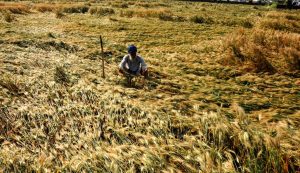An intense ‘western disturbance’ — a wave of moist winds from the Mediterranean region that impacts north India — impacted the region from Feb 29 to March 4, causing hail and thunderstorms in the plains and heavy snowfall in higher Himalayas. The primary producing regions of India have seen unseasonal rains and hailstorms, damaging winter-planted crops including wheat, rapeseed, and chickpeas, which has caused harvesting to be delayed, industry and government sources told. State revenue agencies in Punjab, Haryana, Madhya Pradesh, Uttar Pradesh are now evaluating the degree of damage over wheat, the primary winter grain, was severely damaged in some areas, according to authorities. Unfavorable weather might restrict wheat output growth and make it more difficult for the government to increase stockpiles. In its second advance estimates released last week, the agricultural ministry predicted that wheat output would increase 1.3% to a record 112 million tons. However, fear has started that this figure may potentially be lower if significant crop damage was.
Punjab: Crop losses were reported in 2% to 5% of the cultivable land of Punjab, according to initial estimates. “Crop damage, predominantly wheat and mustard, is distributed across 1.5 lakh hectares (370,658 acres),” stated Jaswant Singh, head of Punjab’s department of agriculture and farmer welfare.
Uttar Pradesh: Crop damage reports came in from all over the Uttar Pradesh. Mahoba and Lalitpur districts recorded losses of more than 40% to standing crops, and other locations in Amethi, Etah, Ghazipur, Gorakhpur, Hardoi, Kaushambi, and Meerut allegedly suffered damage to a third of the crops. When the hailstorm arrived, the wheat and mustard were both at the milking stage. A farmer from Bijnor’s Chandak hamlet named Rajinder Singh stated, “There’s a permanent loss of 15%.” The standing sugarcane crop has sustained significant damage, according to Shamli’s Dharmender Malik.
Haryana: In the districts of Ambala and Kurukshetra, the recent unseasonal rains and hailstorm have impacted the wheat crop on around 70,700 acres and the oilseed crop on approximately 3,720 acres. According to the information obtained, Kurukshetra’s crops on about 63,807 acres—62,200 acres of wheat and 1,607 acres of mustard—have been impacted. Of the total wheat impacted area, 49,300 acres had a crop affected by 0–25%, 12,400 acres had a crop affected by 26–50%, and 500 acres had a crop affected by 51–75%. Comparably, in the case of the mustard crop, 1,315 acres had 0–25% crop damage, 280 acres had 26–50% crop damage, and 12 acres in Kurukshetra had 51–75% crop damage.The site for e-Kshatipurti has opened, and the farmers should get their losses registered there by March 10.
Madhya Pradesh: Thousands more have also been affected by the unexpected calamity in more than 20 districts, including Shivpuri, Tikamgarh, Datia, Chhattarpur, and Guna districts.The storm has destroyed standing crops in the Tikamgarh area of Madhya Pradesh, including mustard, wheat, gram, and lentils. The crops suffered damage in over six villages, including Bamhorikala, Jewar, Uprara, and Lidhaura. Farmers report that the hailstorm that began on Friday damaged 50% of their crops. In Tikamgarh, 1,92,000 thousand hectares are used for wheat cultivation, while 22,900 hectares are used for mustard planting. It is reported by farmers that there is a loss of 25% in mustard and 10% in wheat.
According to a trader with a worldwide trading business located in New Delhi, damage has been observed in all wheat-producing regions, from northeastern Punjab and Haryana to central India’s Madhya Pradesh. This will undoubtedly have an impact on wheat output.
